![]()
![]()
![]()
Use LEFT and RIGHT arrow keys to navigate between flashcards;
Use UP and DOWN arrow keys to flip the card;
H to show hint;
A reads text to speech;
13 Cards in this Set
- Front
- Back
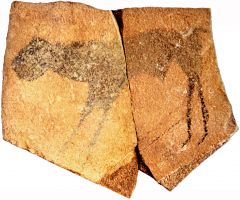
Formal Analysis 1. Apollo 11 Stones Namibia, Africa 25,500-25,300 B.C.E.
Content This is a painting done on a cave wall. It depicts an animal which is the only subject matter. It's significance spurs from the importance of animals in nomadic societies.
Style - Painted with organic/mineral stain - Artist uses shape and color to create the distinct silhouette of an animal. -The figure is contrasted from the rock it is painted on |
This painting is painted on a cave wall, either a home or spiritual dwelling. It provides higher meanings to the artist or people with similar lifestyles/beliefs. This piece represents spiritual beliefs and the belief in animism. It utilizes the importance of animals in hunter/gatherer societies to create a painting with higher meaning. This painting could transform a regular cave, into one with spiritual value. |
|
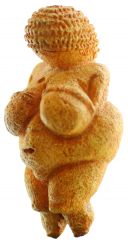
Formal Analysis Venus of Willendorf Austria 25,000 B.C.E.
Content - Stone carving depicting a woman with emphasized breasts and midsection - Theme of reproduction - This was hugely important to paleolithic people because it was key for survival
Style - The artist used shape used shape and contrast to extenuate the reproductive organs - Carved with hand made sharp tools and painted with an ocher paint -Lack of proportion also puts emphasis on certain body parts rather than others |
This is a fertility figurine/statuette. It's small enough to fit in the palm of your hand, which reflects the nomadic society that the artist came from. The statue is meant to represent fertility and life. It is mean to be held or carried rather than stood up on the feet. |
|
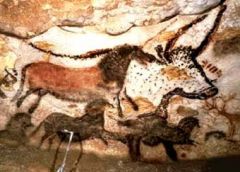
Formal Analysis 2. Great Hall of Bulls Lascaux, France 15,000-13,000 B.C.E.
Content - Large paintings done on a cave wall -There are early forms of horses, bulls, and deer depicted - Animals are the main theme of the piece - The animals illustrate the imperativeness of animals to nomadic people
Style - Organic/ Mineral stains - The artist uses color, texture, and shape to create animals that are mimetic of real animal movement - Artists uses the contrast of the rock surface to create background
|
This piece was larger piece done on a cave wall. This artwork transforms a simple shelter into something different. It portrays the importance of animals in hinting and gathering societies. The work also reveals the evolvement of animals and the greater observance of the artists. It could have also been spiritual, due to its subject matter. |
|
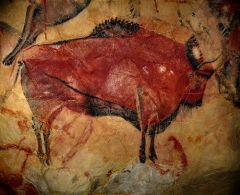
Formal analysis Cave Paintings at Altamira Spain 12,000 B.C.E.
Content - This is painting done on a cave wall - The main subject is the bison animals - The animals represented the importance of animals to these nomadic societies
Style - Organic or mineral stain - Artists uses color, shape and texture to create a life like image - The smooth, bright red puts emphasis on this specific animals rather than the ones around it |
This piece creates a permanent shelter with a higher meaning. It represent the necessity of animals in hunter/gatherer societies and alludes to the animals having a higher spiritual meaning. The work represents advancement in humans understanding of the world around them. |
|
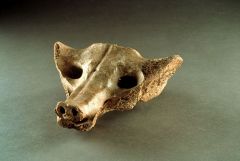
Formal analysis 3. Camelid Sacrum in the shape of a canine Tequixquiac, Central Mexico 14,000-7000 B.C.E.
Content - This is the head of a canine carved into a pelvic bone of another animal - The theme focuses on reproduction and the natural world with the subject matter of a canine and a pelvic bone
Style - This was carved with sharp, hand-made tools - Made using a subtractive technique
- The artist used pre-existing shape to create the form the head of a canine |
This carving may have been used as a mask for spiritual rituals. The artist used a material with important significance already to create something with more significance. It stands for reproduction/life, the importance of animals, and stood for religious purposes as well. This piece was most likely created for the religious/spiritual purposes. |
|

Formal Analysis 4. Running horned woman Tassilin'Ajjer, Algeria 6000-4000 B.C.E.
Content -This is a rock painting done with minerals stains and chalk - The subject matter includes a ornamented running woman in the foreground as well as man figures who appear to be moving in the background. - The theme focuses on the new importance of people, especially in groups, as societies formed in place of hunter/gatherer clans - Also, there is focus on humans, rather than animals. This suggests evolution from the 100% animal based society
Style - Painted on a cliff face - Detailed ornamentation and pattering - Controlled, smooth lines - Layering and transparency are a huge process here - A lot of progression form earlier styles - The artist used texture and lines to reveal the spiritual meaning of the piece |
This painting has a lot of symbolism around the ornamentation of the main figure. The decorations (horns, outfits, texture) suggest that the painting may be depicting a spiritual ritual. Of course, the significance of animals is still demonstrated with the horns, however, this piece has more focus on human importance. The piece also shows human connection to the natural environment with the rain cloud above the figures head. Other symbolism such as the "headless" figures in the background may suggest sacrifice with religious milieu. |
|
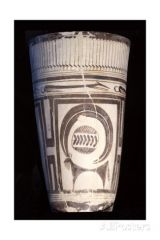
Formal Analysis Bushel with Ibex motifs Susa, Iran 4,200-3,500 B.C.E.
Content - This is a ceramic bushel painted with a mineral stain - The subject matter includes an ibex as well as canine figures - The theme focuses on importance of animals in a new way; the canines as hinters, and the ibex as food
Style -The painted decoration on the bushel is incredibly detailed and precise for the time - The stylistic features on the ibex extenuate the the horns of the animal as a defining characteristic - This is a typical ceramic shape for the area it was discovered in - The artist used space really well, seeing as the images conform to the curve of the vessel |
This piece introduces the idea of storage which leads to the belief that these people were leaning away from nomadic societies and leaning more towards established civilizations. This bushel may have been used to store grains, fruit or other foods. Since the pot was found in a funerary area, some believe it could have been used to hold ashes. There is also belief that it could have been a gift for someone of importance or used in trade because of its very advanced decoration. Also, Susa was a trade hub. |
|
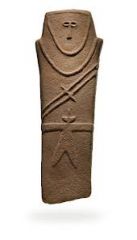
Formal analysis 6. Anthropomorphic Stele Arabian peninsula 4000 B.C.E.
Content - This is a carved stone stele - The subject matter consists of a human, most likely male, figure with knives or other weapons tucked into his sheath and belt - The weapons may represent a warrior
Style - This is a carved stone piece that was shaped to be stood up - The head or face is very stylized. It is simple, but portrays and represents the real thing - The artist uses lines to create the identifying characteristics of the figure |
This piece was made as a sort of tombstone although not confined to funerary processes. It may have been used in the recognition of someone of importance. The piece focuses on the individual. It suggested that societies were no longer focused on animals/groups for survival only. It leads to the belief that individual humans were being recognized. However, there is still emphasis on humans connection to the natural world and their knowledge of natural material and how to manipulate it. |
|
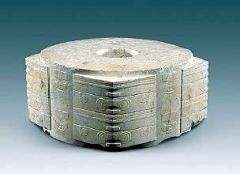
Formal analysis 7. The Jade Cong Liangzhu, China 3300- 2,200 B.C.E
Content - This is a carved piece of jade - The subject matter is limited to the jade and its carved decorations - The decorations signify a piece of high status because of their extreme, intricate detail
Style - The piece was carved using the retractive method on a piece of jade - The incized design are very intricate and detailed - The above mentioned intricacy of the designs suggest the importance of this piece in the society it was foubnd |
The designs on this piece have led to the belief that it was used for trade (high value), ornamentation, or it may have even been reserved for those of wealth. This piece is one of many found, however, this specific one had much more detailed designs. |
|

Formal analysis 8. Stonehenge Wiltshire, U.K., Neolithic Europe 2,500-1,600 B.C.E.
Content - These are slightly carved, stacked stone pieces - The stones are arranged in a patter in coherence with eclipses and astronomical cycles - This was really important because it could have been a form of ancient calendar
Style - These stones were taken out of a hillside and moves hundreds of miles to this sight - The stones are slightly carved away in an subtractive matter -Two concentric circles - Stacked in megaliths (Post on sides and lintel on top) which is a huge architecture technique today - Lentils acctually conform to the curve of the circle |
The purpose of Stonehenge is to serve as an ancient form of a calendar. There are two concentric circles of rock. If you stood in the direct center and looked at a specific stone called the "heel stone" on the morning of a summer or winter solstice, the sun would rise directly above the heel stone. The structure also predicted solar eclipses and was a astronomical calendar if you will. |
|
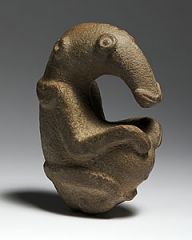
Formal Analysis 9. The Ambum Stone Ambum Valley, Enga province, Papua New Guinea 1,500 B.C.E.
Content - This is a very polished carved stone that was based on an animal found in the area of it's creation - The animals significance most likely relates to humans dependance upon animals for survival - Also, the animal's round belly could be significant
Style - This sculpture was modeled in three dimensions which adds to its air of realism - The structure is retreated to free the head and it stands on its own, therefor the sculpture itself is in the round - The stones surface is polished to achieve the animal's texture - The artist uses form to create realism throughout the piece, however, there is elements of style in the "simpleness" of the aniaml |
The purpose of this piece is not entirely known or understood. However, the piece does allow us to see the that people were working with the natural material to reflect upon their experience with the natural environment.
|
|
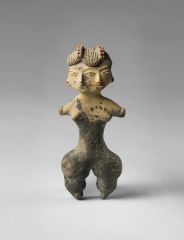
Formal analysis 10. Tlatilco female figurine Central Mexico, sight of Tlatilco 1,200 - 900 B.C.E.
Content - This is a figurine or statuette that is obviously a woman - The figure is of a woman with two heads and exaggerated hips - The significance of the multiple heads may be fascination with physical deformities or it may be depicting a rare deformity known as diprosopus, literally "two-faced" conjoined twins. Diprosopus was probably meant to symbolize duality which was a common topic in Mesoamerican religions
Style - This figurine is ceramic - Facial features are carved - The artsist used shape to emphasize certain parts of the body - The artist also utilized proportion to reach the same affect - There is also evidence of paint used for decoration |
Likely, the purpose of this figurine was to symbolize religious ideas such as duality. Due to the pieces size, we know that it was meant to be portable however, it was not meant to be a free standing piece. |
|
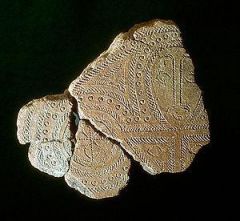
Formal analysis Terracotta fragment Solomon island/ Reef islands, Lapita 1,000 B.C.E.
Content - This is geometirc designs incised in a piece of pottery -This particular design includes an anthropomorphic face which was common for Lapita art - The design could have increased the trade value of the pot or signified it as one of more importance
Style - The designs are put into the wet clay using many comb like tools that each have a simple pattern - When all the patterns come together is forms intricate patterns - The artist used lines to create a face within the pattern
|
Often time the pots, that pieces like this come from, were used for cooking, storing, or serving food. The design sometimes included anthropomorphic or zoologic patterns that may signify a specific person, or the importance of the individual in general. |

